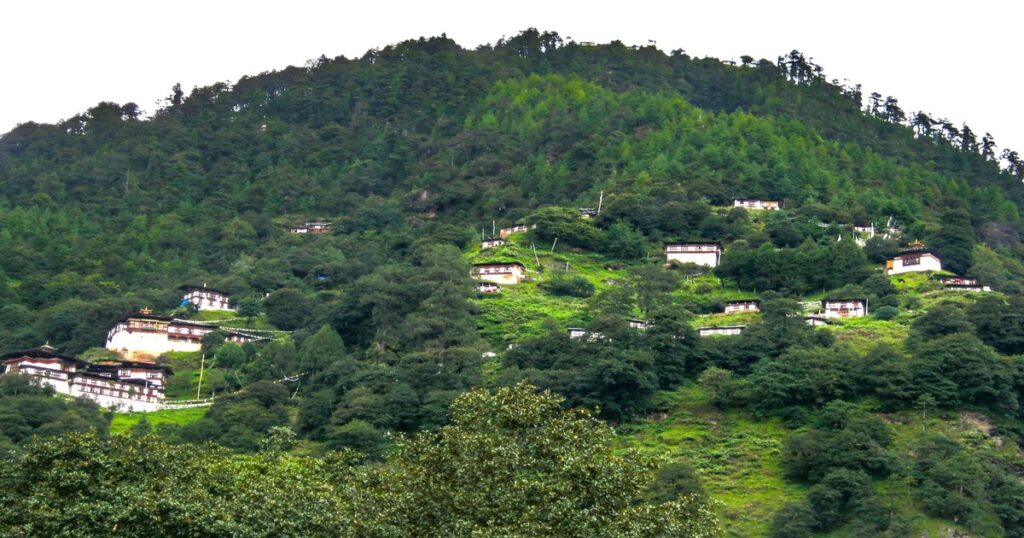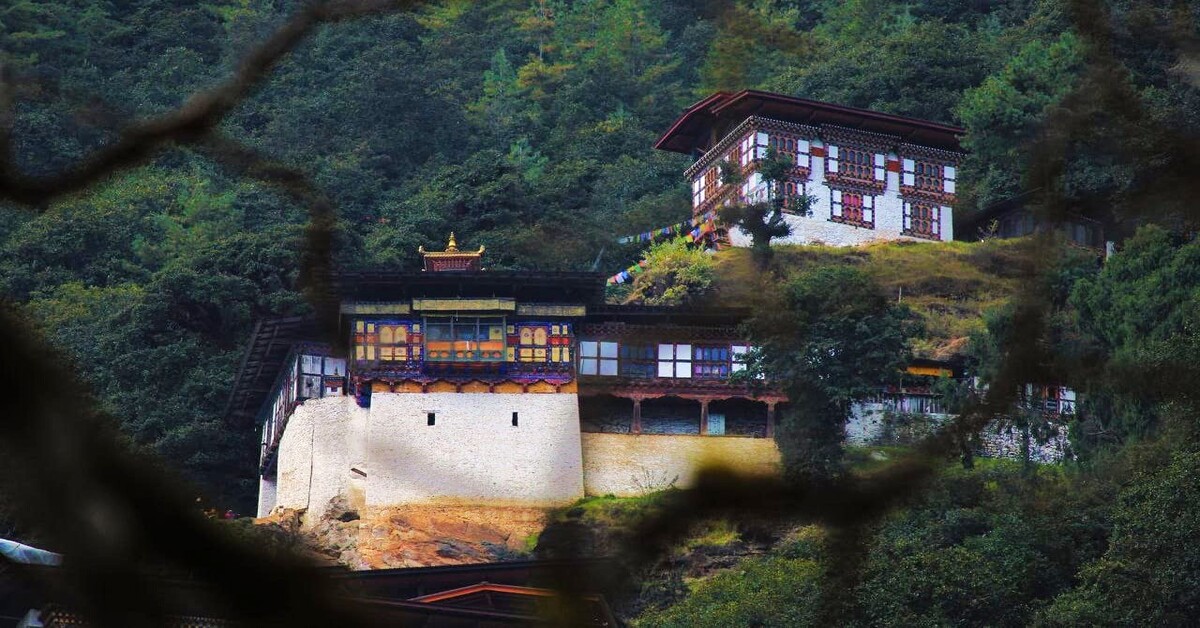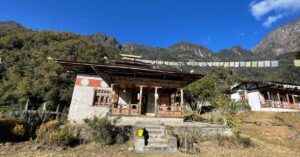Cheri Monastery, also called Chagri Dorjeden Monastery, is the first monastery in Bhutan founded by Zhabdrung Ngawang Namgyal in 1620. It is located on the south face of an Iron Hill (Chagri), in the shape of the heart of Mahakala’s Palace at 2852 meters above sea level, adjacent to Tango Monastery.
Zhabdrung Ngawang Namgyel started building the Chari Vajraya Monastery in 1620 and completed it in 1623. In 1621, he enrolled 30 monks and instituted the first Drukpa monastic order.
The monastery is now the Drukpa Kagyu School’s major teaching and retreat center. Today, it serves as a retreat center for Dorden Tashithang Buddhist University graduates and monks of the Central Monastic Body who undergo meditation for three years, three months, and three days.
How To Reach Cheri Monastery
Cheri Goemba monastery is situated at the northern end of Thimphu Valley, about 15 kilometers from the city center. It takes a half-hour ride from Thimphu city to the Dodeyna parking lot. From there, it is about 1.6 km, elevating 270m, and takes about an hour to hike up the steep hill to reach the monastery.
Cheri Monastery Hike
The hike to Cheri monastery starts from the Dodena base and takes 40-60 minutes of an uphill hike. Walk across the cantilever bridge over the Thim-Chu River and around the chorten. There are many nearby sacred sites to visit. The hike is fairly easy. When you are more than halfway, you will reach a resting place. There is a stupa and canopies. At the monastery, you can see the free-roaming goral, a near-threatened species of goat-like mammals. You can complete the Cheri Gompa monastery and Tango Choying Dzong hikes together.
Sacred Relics to See at Cheri Monastery
- Statue of Chab Goen Ngawang Namgyel;
- Sacred religious items of Zhabdrung;
- Sacred oven of Zhabdrung;
- Kudung Chorten of Tenpai Nyima, father of Zhabdrung;
- Tibetan commander Gula’s heart and hands;
- Cremation rock of Desi Umdzey Tenzin Drugyal;
- Statues of Guru Rinpoche, Buddha Sakyamuni, Nagarjuna, and Dharma King Songtsen Gampo.

Historical Significance of Chari Monastery
According to the history of Cheri Monastery, Guru Rinpoche visited Chari Mountain and prophesied, “The life fortress Drukpa will be founded between the two rivers, and will be the first religious community in the Iron Monkey Year 1620 corresponding to the 10th Rabjung.” Cheri Mountain was also visited and blessed by Phajo Drugom Zhigpo in the 13th century.
When Zhabdrung arrived in Thimphu, the grandson of Divine Madman Drukpa Kunley, Tshewang Tenzin, offered him the Tango Choying Dzong located opposite Cheri Mountain. Zhabdrung stayed in retreat there. Unfortunately, his father, Mipham Tenpa Nyima, passed away in Tibet in 1619. Zhabdrung’s followers secretly smuggled the remains of his father to Tango.
After the elaborate funerary services at Tango, Zhabdrung performed divination before the sacred Rangjung Kharsapani for a suitable site to construct the Kudung Chorten, a reliquary stupa to house the sacred remains of his father. He also sought the auguries of the protective deity, Yeshey Goenpo. Both divinations pointed to Chari Mountain (iron hill). It is said that the Rangjung Kharsapani predicted three times that the remains of Tenpai Nyima should be kept at Cheri as a sacred relic.
Kudung Chorten
Zhabdrung built Kudung Chorten, which was called “Ngul Bum Chorten,” to enshrine his father’s ashes. The Kudung Chorten was built by five Newari craftsmen from Nepal, in addition to the Bhutanese volunteers, after the arrival of Zhabdrung’s teacher, who approved the proportions (thigtshed) of the stupa.
The Construction of Chari Monastery
Zhabdrung laid the foundation of the three-storied Chari monastery on the 21st day of the 5th month of the Iron Monkey Year, corresponding to 1620. Cheri Monastery was built by Zhabdrung’s attendants, patrons, and devotees under the supervision of Tango Choeje Mipham Tshewang Tenzin. It was completed in three and a half years in 1623. Cheri Monastery became the first and oldest monastery built by Zhabdrung in the 17th century.
Architecture
Cheri Monastery was built with defensive considerations as Zhabdrung faced danger from Tibet and within Bhutan. Its overall design is a cliffside adaptation of the flatland, like the Gangteng Monastery in Wangdue Phodrang. The monastery features a tall mandala-shaped utse found more commonly in dzong architecture than in monasteries. The other major buildings are arranged to act as fortified walls with rooftops overlooking one another at varying elevations. To help prevent unauthorized entry, the frontage of the ground floors has very few windows. However, the long galleries of rabsel windows provide sufficient lighting on the uppermost floors.
Institution of First Sangha (Drukpa Monastic Order)
Before the completion of the monastery, Zhabdrung instituted his first Sangha by enrolling 30 monks in 1621. This marked the formal establishment of Zhung Dratshang in Bhutan. The monks at the monastery were regulated by the constitutional and procedural framework Zhabdrung had drawn up for his first monastic community in Ralung in Tibet. They followed a set of religious curricula and the strict code of conduct known as Chayig Chenmo. He and his Yongzin imparted regular teachings to the first batch of monks at the Chari monastery.
Unification of Bhutan
After building the Chari monastery and operationalizing the monastic institution, in 1623, Zhabdrung entered into a three-year retreat in a cave just above the main structure. As a firm believer in prophecies, dreams, and the workings of karma, Zhabdrung wanted to use the time in retreat to contemplate his next step.
On the completion of his retreat, Zhabdrung decided to follow the path of Milarepa and Gyalwa Lorepa and retire to the mountains for further meditation. However, the statue of his father spoke, “You shall look after the doctrine through temporal and spiritual systems.”
Besides that, the Devas and Gurus had predicted over and over again that the time had come for Zhabdrung to serve the sentient beings. Therefore, at the age of 34, Zhabdrung undertook the responsibility of turning the Golden Wheel of Spiritual and Temporal Laws.
The Sacred Relics of Cheri Monastery
The main relic of Chari monastery is the silver funeral stupa containing the ashes of Zhabdrung’s father, Yab Tenpai Nyima. Kudung Chorten also houses the statue of Tenpai Nyima, sculptured by Zhabdrung himself, who had spoken to him.
Another treasure of Cheri monastery is the Goenkhang, which is dedicated to the guardian deities. The monastery also has Zhabdrung’s personal belongings. Besides, there is a sacred oven, which Zhabdrung lifted with one hand during a ceremony after the completion of his retreat. In the chapel of Mahakala, the Tibetan commander Gula’s heart and hands are also preserved as sacred relics.
Chari Monastery is also home to the golden statue of Zhabdrung Rinpoche in the Duedulphug temple, made by the 9th Desi, and the golden statues of Guru Rinpoche and Phajo Drukgom Zhigpo in the Lama Lhakhang, and the golden statue of Namse in the treasure room.
In 1967, with support from Her Late Grand Queen Mother Ashi Phuntsho Choden Wangchuck, the 65th Chief Abbot Yeshey Singye established the retreat center.
The Restoration of Chari Monastery
Her Majesty the Queen Mother Ashi Kesang Choden Wangchuck graciously renovated the main and Duedul temples. In addition, eight new apartments of Thuenkhang (prayer halls) and drupkhangs were constructed.
On April 10th, 2016, His Majesty the King offered 6 sandalwood boxes to Cheri Monastery. Fringed with a gold-plated metal carving of traditional design, the 6 dark reddish chests, ranging from some 35 kg to 55 Kg, would be used to store important relics belonging to Zhabdrung Ngawang Namgyel. His Majesty personally carried one of the 55 kg boxes up to the monastery, which is located on a hill in Dodeyna, about an hour’s walk from the road.
Annual Rituals at Cheri Monastery
Every year, the Chagri Dorjeden Monastery performs the following rituals:
- Tshethro (wrathful amitayus) from the 1st to the 3rd of the first month;
- Mithrugpa (Akshobhaya) from the 8th to the 10th of the same month;
- Neten Chudrug (16 Sthaviras) on the 15th day of the first month;
- Zhabdrung Kuchoe from the 8th to the 10th of the third month;
- Neten Chudrug on the 15th day of the fourth month;
- Neten Chudrug on the 4th day of the sixth month; and
- Neten Chudrug on the 22nd day of the ninth month.
In total, 13 days of ceremonies are performed every year for the benefit of all sentient beings.
Best Time to Visit Chari Monastery
The best time to visit Cheri Monastery is spring and autumn, from March to May and September to November. The mild weather, fewer crowds, and coinciding religious festivals make spring and autumn the ideal time to visit Chagri Monastery and fully experience its spiritual and natural beauty. The scenic hike to the monastery is also most enjoyable during these seasons. You can visit major pilgrimage sites in Thimphu with the Bhutan Pilgrimage Package.
What to Bring on a Chari Monastery Hike
To ensure a comfortable and enjoyable hike to the Cheri Monastery in Bhutan, consider bringing the following items:
- Comfortable Hiking Shoes: The hike is approximately 2 kilometers uphill and takes about 1 hour and 30 minutes. Wear sturdy, comfortable shoes suitable for the terrain.
- Clothing: Dress in layers for the changing weather conditions. Bring a hat, sunglasses, and sunscreen for protection.
- Water and Snacks: Bring enough water and snacks to keep you hydrated and energized throughout the hike.
- Camera: Bring a camera to capture these moments.
Other Sacred Sites to Explore in Thimphu
Dechenphu Lhakhang: It is a monastery dedicated to Geynyen Jagpa Melen, a powerful protective deity, located at the northern end of the Thimphu Valley in Bhutan. The Temple was constructed in the 12th century by Dampa, the son of Phajo Drugom Zhigpo.
Pangri Zampa Monastery: It is one of Bhutan’s oldest monasteries, founded in the 16th century by Ngawang Chogyal, located 8 kilometers north of Thimphu on the west bank of the Thimphu River. The monastery now functions as Bhutan’s Royal College of Astrology, where monks study traditional astrology, and the college is responsible for determining dates for important national events.
Tango Monastery: The Tango Choying Dzong was founded in the 13th century by Phajo Drugom Zhigpo and rebuilt in its current form in 1688 by the Fourth Temporal Ruler, Tenzin Rabgye. The monastery is perched on a forested hillside near Cheri Mountain, famed for its spiritual legends, particularly the prophecy involving the deity Hayagriva.
Thuji Dra Monastery: Also known as the Cliff of Compassion, it is one of the four cliffs prophesied by Guru Rinpoche to Phajo Drugom Zhigpo. The Thujidra Temple is located at an altitude of nearly 4,000 meters, where Phajo saw in a vision Phagpa Thujechenpo while meditating here.
Domendrel Tsho: It is a sacred lake located near the site where Gyalse Tenzin Rabgye offered mandala offerings to consecrate the Palace of Sikkim’s King Chador Namgyal in the 17th century. The hike to Domendrel Tsho starts from the base of Tango Monastery, and typically takes 4-5 hours.
Enjoyed reading this blog?




